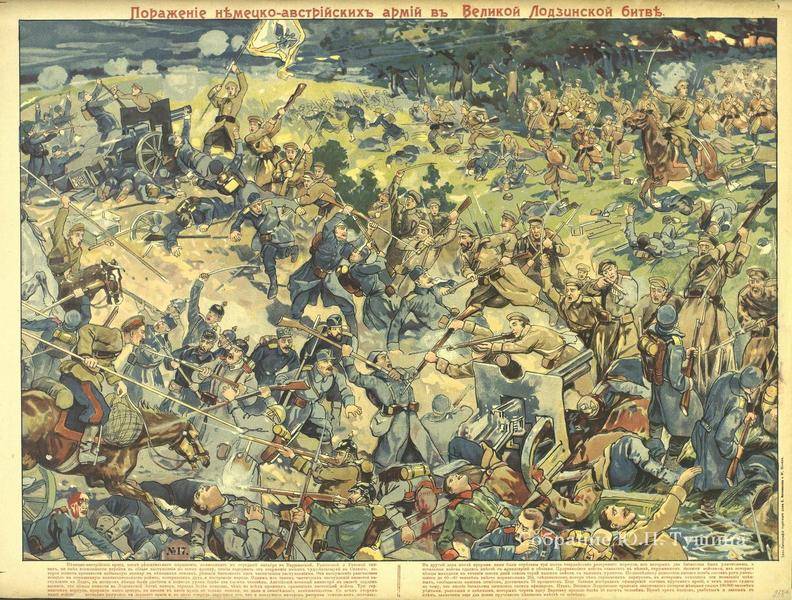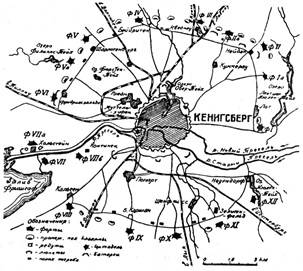1914. Entente Blitzkrieg
Hypothetical situation: East Prussian operation is successful
As shown in previous sectionThe defeat of the Northwest Front was not predetermined. Moreover, initially the chances of the Russian army were higher. Consider a hypothetical situation in which the East Prussian operation ended in success.

What is success for Russia? The minimum program is the siege of Konigsberg and the occupation of the territory to the Vistula. The maximum is an attack on Berlin.
Such an event could take place in two scenarios:
1. General Pritwitz immediately withdraws the field forces beyond the Vistula, returning the garrison to Koenigsberg and possibly reinforcing it with the landver brigades.
2. Hindenburg does the same if it fails to defeat Samsonov or if Renenkampf manages to advance towards the 2 Army, threatening to take the 8 German Army in ticks.
But if you understand it well, it doesn’t matter which scenario will be chosen. In both the first and second cases, the balance of forces will change little, if at all.
The result will be a siege, blown up bridges, powerful German fortresses making the crossing of the Vistula almost hopeless and rare troops on both banks in order to prevent each other if someone decides to build a pontoon crossing for an unexpected sortie.
This means the transfer of the next phase of hostilities to the south from the German Thorn to the Russian Lodz.
To simulate the course of the battle is an unproductive task. But on the other hand, it is possible to predict a possible outcome based on the results of the Warsaw-Ivangorod operation with great reliability.
The main question: what kind of forces will the parties have in the Warsaw area? It is clear that in this case the battle will take place with a different sign. Russian troops will advance, German defenses.
What is a Konigsberg blockade? How big is this event?
The main fortress position was a belt of 12 large forts, 3 small and 24 infantry and artillery shelters. The position is 5 km away from the outskirts of the city, has a diameter of up to 13 km, and a general contour of about 40 km. The distance between large forts depending on local conditions is within 2 - 4 km. In terms of size, quantity and quality of fortifications, Konigsberg is similar to the Austrian Przemysl. In addition, during the war, the fortress was supplemented by a line of field fortifications along the banks of the Pregel and Deyma rivers, and from the sea side it could be supported fleet.
Under Przemysl, blocking forces totaled up to 280 thousand people, although the second-level army of General Selivanov, numbering 70-80 thousand people, was directly engaged in the siege. The siege lasted 6 months, and the fortress was taken after the 3 assault. In fairness, it should be said that the Austrians repeatedly made attempts to unlock, diverting the besieging army.

What forces would have been left at Koenigsberg? I would venture to suggest that it would be the 2th Samsonov’s army, since only it had three divisions of heavy artillery — the 36 guns. But the cavalry, numerous and useless in the siege, was part of the 1 Army.
Based on this, it is worth considering the forces of the parties for the Lodz offensive operation.
Throw west
Can the Germans transfer additional reserves from the Western Front, in addition to the well-known two corps and the cavalry division? Theoretically, yes. But in this case, it would be necessary to finally bury the plans for the capture of Paris and the withdrawal of France from the war. And on 05 of September the battle on the Marne began. If they start shooting, then the Miracle on the Marne will be much more wonderful than in the real stories. If the plans are violated, the Germans tend to panic. But not to the same extent.
In real history, by September 15 in September there was a German 9 army (135 600 bayonets, 10 400 sabers, 956 guns, including the garrison of the Thorn fortress) and the Austrian 1 army (155 000 bayonets, 10 000) in front of Warsaw. Total 666 thousand bayonets and sabers.
They were opposed by 2,4,5 and 9 armies - 470 000 infantry, 50 000 cavalry. Total 520 000 bayonets and sabers.
Moreover, part of the 9 of the German army was made up of corps from the composition of 8, namely 17 and 20. That is, in the case of the abandonment of East Prussia, the remnants of the 8 army should be added to the German forces. But not all, since Pritz (or Hindenburg) will be forced to leave the land divisions in the Fortress and on the banks of the Vistula. I will assume that Pritvits will add 2 army corps (1 and 1 reserve).
However, in the considered version of the offensive, the Axis will not be. Therefore, from further calculations it will be quite correct to remove the 1 Austrian army, as well as the Russian 9 army opposing it and the 2 infantry divisions of the Warsaw fortified area. That is, about 200 of thousands of bayonets and sabers will confront the Russian offensive. And if the Austrians try to help the allies, then due to a gap of one and a half hundred kilometers, this will be an independent battle.
In an attack on Germany could participate:
- 1 A, reinforced by the 2 AK, the 2 Siberian Corps, the 79 and 50 Infantry Divisions, the 1 Cavalry Corps, the Caucasian, Guards and Cossack Divisions, which in real history were part of the 2 Army in the Warsaw area. That is, we can conditionally accept that 1A would be equal in strength to the September 2A from real history;
- 4 and 5 armies from real history.
But in the situation under consideration, Russia has an ace up its sleeve called the 10 Army. What is the 10 army? These are the 11 infantry and 2 cavalry divisions. Approximately 130 000 bayonets and sabers.
Together, this gives up to 460 000 bayonets and sabers from Russia.
In real history, the Warsaw-Ivangorod operation had a balance of forces 1,6 to 1 (520 to 311) in favor of Russia. In our case, there will be 2,3 to 1 (460 to 200).
If we assume that the 8 army went out with battles, the number of troops on both sides will decrease slightly, but the ratio of 2,3 to 1 will remain, because during direct clashes the Russians and Germans suffered equal losses. Therefore, to calculate the balance of forces, the way the 8 army came out, with or without battles, does not matter.
The Warsaw-Ivangorod operation had the following result:
Russia. Number 520 thousand Losses 110 thousand, or 21%.
Germany + Austria-Hungary. Number 311 thousand Losses 148 thousand, or 47%.
With the ratio of forces not 1,6 to 1 (520 to 311) but 2,1 to 1 (460 to 200), the losses will be different.
It can be expected that during the time of the Torno-Lodz Operation (10 days), during which the Russian troops will not defend, but advance, army losses can amount to:
Russia is 70-80 thousand people, and will not exceed 20% of the initial number, which means maintaining the offensive potential.
Germany may lose up to 130 thousand people. Those. not 47% as in RI, but more than 60% of the initial composition. This is a rout.
Bottom line - the path to Silesia is open, the cavalry of Khan Nakhichevan gets the opportunity to justify his existence and rush along the left bank of the Vistula to Danzig bypassing the attached fortresses. The Germans will have to hastily withdraw troops from the Western Front in order to build a line of defense along the Oder.
Further fantasy does not make sense. There are a lot of development options.
Script Weakness
The weak point of the painted picture is the readiness of the French and English to sit on the heels of the Germans and rush after them to the Rhine. The battle on the Marne ended on 12 of September and during it the French ran out of steam. But do not forget that the trench war has not yet begun. German barriers to rely on trench lines and barbed wire are not trained, and there is no time. The possibility of a jerk appears. Will they use it? If you take advantage, then after the French and British exit to the Rhine, it will be quite possible to begin negotiations on an honorable surrender. And then the war would get a chance to end before the white flies.
Why all these calculations? And the fact that the sad outcome of the war for Russia was not at all predetermined. And do not represent Russia as a weak link. Especially knowing the role of Great Britain in unleashing a world carnage.
But that would be a completely different story.
Information